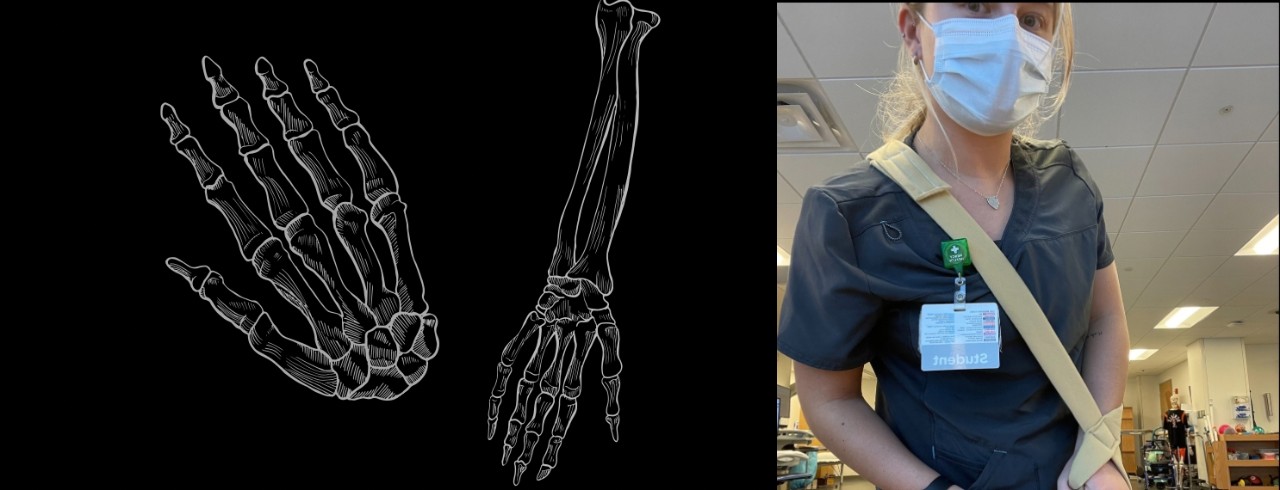
UC Makerspace's 'hands-on' approach for occupational therapy students
Gaining experience in adaptive device design
Innovation in action occurs regularly inside the University of Cincinnati's Ground Floor Makerspace.
Designing or adapting devices for individuals with unique needs is an essential skill for students to develop as they pursue their master’s degrees in occupational therapy (OT) through the UC College of Allied Health Sciences.
“The ability to adapt and provide solutions to common occupational performance problems has been a defining trait of occupational therapists since the profession's infancy," Karen Craven, assistant professor, College of Allied Health Sciences, and faculty in the Master of Occupational Therapy Program at UC, said. "Regardless of our work settings, we need to help our clients find another way to accomplish an important task.”
Many of these adaptations or designs can be “low fidelity,” utilizing common materials such as PVC pipe, duct tape and zip ties to form simple solutions. However, through collaboration with the Ground Floor Makerspace staff, students are being introduced to ways they can take their ideas to impact by using state-of-the-art tools and equipment to create assistive devices.
Types of devices
In their spring semester, students are introduced to 3D printing and can print assistive devices from open-source plans that match clients' needs in case studies.
UC Makerspace Manager Benjamin Jones leads operations inside the space to support new and highly skilled makers.
“Exposure and training on 3D printing, as well as the variety of certifications we offer for OT students, are intended to prepare them for advanced course work for future success,” Jones said.
These devices range from:
- Adaptive grips for knitting needles
- Writing implements
- Models of hands with moveable digits
- Oven rack push and pulls
Students then attend certification classes and complete a project using either sewing, woodworking or laser-cutting training.
My team and I are excited to assist professors like Karen Craven, who utilize the resources of Makerspace as a platform for exploration for students to discover innovative ideas and solutions.
Benjamin Jones UC Ground Floor Makerspace manager

Adaptive sling design created by occupational therapy student Emma Schmitt
Fit for a new life
The UC Ground Floor Makerspace is the purveyor that brings ideas to life in every way imaginable. Located inside the 1819 Innovation Hub, the 12,000-square foot space introduces OT students to a variety of tools they can use, such as:
- 3D printers
- Laser cutters
- Sewing machines
- Power tools
“A big part of my role is developing and managing relationships with faculty and administrators interested in integrating iterative making into their curriculum,” Jones said. “My team and I are excited to assist professors like Karen Craven, who utilize the resources of Makerspace as a platform for exploration for students to discover innovative ideas and solutions."
Through the makerspace collaboration, students:
- Learn new skills
- Explore and expand their imaginations
- Gain confidence and certifications
- Increase creative adaptive solutions to perform meaningful everyday activities.
Why it matters
Occupational therapists assist people with disabilities or injuries in resuming performance in tasks that are essential to daily living and work.
The occupational therapy program at UC is a hands-on learning experience essential for OT students to engage in designing, creating and building prototypes to meet various needs.
“Access to the makerspace helps increase students' awareness of materials and methods used to fabricate solutions to everyday activity issues,” Craven said.
“As our profession continues to grow, I’d like to see more occupational therapists involved in design teams for products, equipment and other devices because we have a unique position in health care of understanding the client factors affected by injury, illness or disability as well as the task demands and the environments in which those tasks occur."
Adaptive solutions
OT students are paired with volunteers, mainly engineers, on real client cases, where they develop ideas for assistive devices that are not commercially available or are uniquely fabricated for the individual.
One of Craven’s students, Emma Schmitt, recently completed a sewing certification from the makerspace and made a walker bag in spring 2022. While involved in fieldwork, Schmitt sketched out and sewed a customized sling for a patient with a weak arm due to a stroke.
“It’s a really simple adaptive solution, but had I not learned these sewing basics in the makerspace, I would not have been able to make this sling to help protect the client’s arm in performing gait and transfer activities.,” Schmitt said.
Impact Lives Here
The University of Cincinnati is leading public urban universities into a new era of innovation and impact. Our faculty, staff and students are saving lives, changing outcomes and bending the future in our city's direction. Next Lives Here.
Related Stories
How aerospace is turning to trustworthy AI
January 6, 2026
UC College of Engineering and Applied Science graduate Lynn Pickering talks to the Ohio Federal Research Network about her research into artificial intelligence and the future of AI in aerospace engineering.
Chris Higgins named UC Foundation Vice President for Development, Academic Health Enterprise
January 6, 2026
The University of Cincinnati Foundation is pleased to welcome Chris Higgins as the new Vice President for Development, Academic Health Enterprise.
What's behind the mysterious rise of migraines?
January 5, 2026
Weather patterns such as extreme heat and storm conditions have been linked to migraine attacks, and research shows those environmental conditions are becoming more common. As National Geographic recently reported, one of the leading theories behind this mysterious rise is that climate change may be playing a role.
